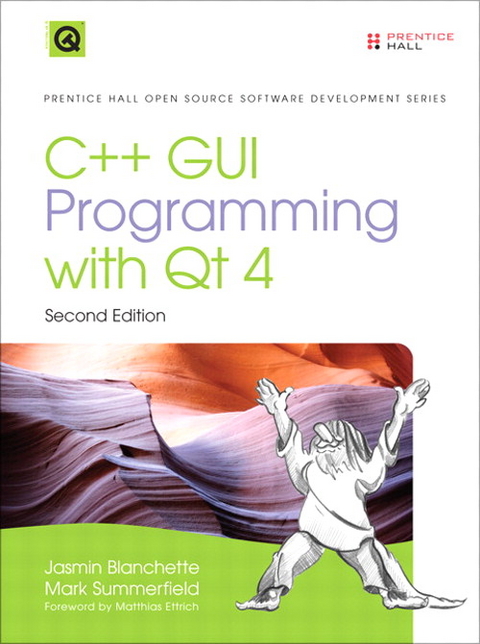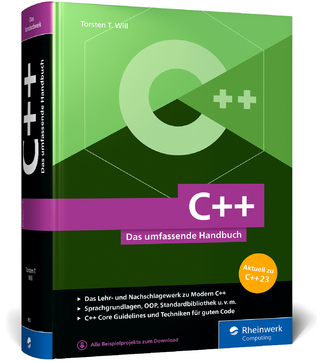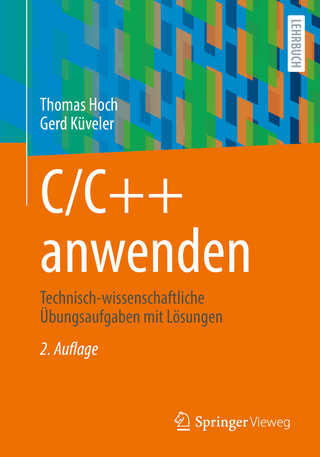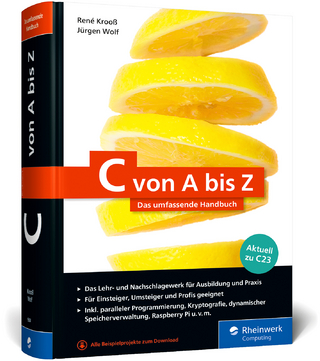
C++ GUI Programming with Qt4
Prentice Hall (Verlag)
978-0-13-235416-5 (ISBN)
- Titel ist leider vergriffen;
keine Neuauflage - Artikel merken
Packed with realistic examples and in-depth advice, this is the book Trolltech uses to teach Qt to its own new hires. Extensively revised and expanded, it reveals today's best Qt programming patterns for everything from implementing model/view architecture to using Qt 4.3's improved graphics support. You'll find proven solutions for virtually every GUI development task, as well as sophisticated techniques for providing database access, integrating XML, using subclassing, composition, and more. Whether you're new to Qt or upgrading from an older version, this book can help you accomplish everything that Qt 4.3 makes possible.
Completely updated throughout, with significant new coverage of databases, XML, and Qtopia embedded programming
Covers all Qt 4.2/4.3 changes, including Windows Vista support, native CSS support for widget styling, and SVG file generation
Contains separate 2D and 3D chapters, coverage of Qt 4.3's new graphics view classes, and an introduction to QPainter's OpenGL back-end
Includes new chapters on look-and-feel customization and application scripting
Illustrates Qt 4's model/view architecture, plugin support, layout management, event processing, container classes, and much more
Presents advanced techniques covered in no other book—from creating plugins to interfacing with native APIs
Includes a new appendix on Qt Jambi, the new Java version of Qt
Jasmin Blanchette is a Trolltech senior software engineer and is writing his M.Sc. thesis in computer science at the University of Oslo. Mark Summerfield works as an independent trainer and consultant specializing in C++, Qt, Python, and PyQt, and is the author of Rapid GUI Programming with Python and Qt. Blanchette and Summerfield coauthored C++ GUI Programming with Qt 3 and the first edition of C++ GUI Programming with Qt 4.
Series Editor's Note xiForeword xiiiPreface xvAcknowledgments xviiA Brief History of Qt xixPart I: Basic Qt 1. Getting Started 3Hello Qt 3
Making Connections 5
Laying Out Widgets 6
Using the Reference Documentation 10
2. Creating Dialogs 13Subclassing QDialog 13
Signals and Slots in Depth 20
Rapid Dialog Design 23
Shape-Changing Dialogs 31
Dynamic Dialogs 38
Built-in Widget and Dialog Classes 39
3. Creating Main Windows 45Subclassing QMain Window 46
Creating Menus and Toolbars 50
Setting Up the Status Bar 55
Implementing the File Menu 57
Using Dialogs 63
Storing Settings 69
Multiple Documents 71
Splash Screens 74
4. Implementing Application Functionality 77The Central Widget 77
Subclassing QTableWidget 78
Loading and Saving 84
Implementing the Edit Menu 87
Implementing the Other Menus 91
Subclassing QTableWidget Item 95
5. Creating Custom Widgets 105Customizing QtWidgets 105
Subclassing QWidget 107
Integrating Custom Widgets with QtDesigner 117
Double Buffering 121
Part II: Intermediate Qt 6. Layout Management 141Laying Out Widgets on a Form 141
Stacked Layouts 147
Splitters 149
Scrolling Areas 152
Dock Windows and Toolbars 154
Multiple Document Interface 157
7. Event Processing 167 Reimplementing Event Handlers 167
Installing Event Filters 172
Staying Responsive during Intensive Processing 175
8. 2D Graphics 179Painting with QPainter 180
Coordinate System Transformations 185
High-Quality Rendering with QImage 193
Item-Based Rendering with Graphics View 195
Printing 217
9. Drag and Drop 227Enabling Drag and Drop 227
Supporting Custom Drag Types 232
Clipboard Handling 237
10. Item View Classes 239Using the Item View Convenience Classes 240
Using Predefined Models 247
Implementing Custom Models 252
Implementing Custom Delegates 266
11. Container Classes 273Sequential Containers 274
Associative Containers 282
Generic Algorithms 285
Strings, Byte Arrays, and Variants 287
12. Input/Output 295Reading and Writing Binary Data 296
Reading and Writing Text 301
Traversing Directories 307
Embedding Resources 308
Inter-Process Communication 309
13. Databases 315Connecting and Querying 316
Viewing Tables 322
Editing Records Using Forms 324
Presenting Data in Tabular Forms 330
14. Multithreading 339Creating Threads 340
Synchronizing Threads 343
Communicating with the Main Thread 349
Using Qt's Classes in Secondary Threads 356
15. Networking 359Writing FTP Clients 359
Writing HTTP Clients 368
Writing TCP Client-Server Applications 371
Sending and Receiving UDP Datagrams 381
16. XML 387Reading XML with QXmlStream Reader 388
Reading XML with DOM 395
Reading XML with SAX 400
Writing XML 404
17. Providing Online Help 407Tooltips, Status Tips, and "What's This?" Help 407
Using a Web Browser to Provide Online Help 409
Using QText Browser as a Simple Help Engine 411
Using QtAssistant for Powerful Online Help 414
Part III: Advanced Qt 18. Internationalization 419Working with Unicode 420
Making Applications Translation-Aware 423
Dynamic Language Switching 429
Translating Applications 435
19. Look and Feel Customization 439Using Qt Style Sheets 439
Subclassing QStyle 454
20. 3D Graphics 471Drawing Using OpenGL 471
Combining OpenGL and QPainter 477
Doing Overlays Using Framebuffer Objects 484
21. Creating Plugins 491Extending Qt with Plugins 492
Making Applications Plugin-Aware 502
Writing Application Plugins 505
22. Application Scripting 509Overview of the ECMA Script Language 510
Extending Qt Applications with Scripts 519
Implementing GUI Extensions Using Scripts 523
Automating Tasks through Scripting 530
23. Platform-Specific Features 543Interfacing with Native APIs 543
Using ActiveX on Windows 547
Handling X11 Session Management 559
24. Embedded Programming 567Getting Started with Qt/Embedded Linux 568
Customizing Qt/Embedded Linux 570
Integrating Qt Applications with Qtopia 571
Using Qtopia APIs 576
Appendixes A. Obtaining and Installing Qt 589B. Building Qt Applications 593C. Introduction to Qt Jambi 605D. Introduction to C++ for Java and C# Programmers 623Index 665
| Erscheint lt. Verlag | 21.2.2008 |
|---|---|
| Reihe/Serie | Prentice Hall Open Source Software Development Series |
| Verlagsort | Upper Saddle River |
| Sprache | englisch |
| Maße | 183 x 242 mm |
| Gewicht | 1402 g |
| Themenwelt | Informatik ► Programmiersprachen / -werkzeuge ► C / C++ |
| Informatik ► Software Entwicklung ► Objektorientierung | |
| ISBN-10 | 0-13-235416-0 / 0132354160 |
| ISBN-13 | 978-0-13-235416-5 / 9780132354165 |
| Zustand | Neuware |
| Haben Sie eine Frage zum Produkt? |
aus dem Bereich


